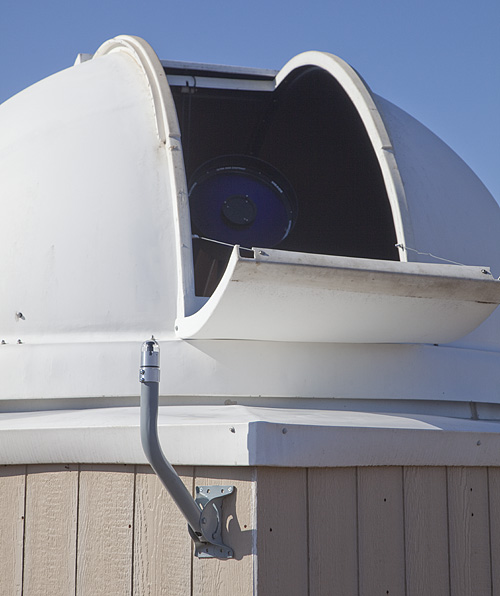| ||||||||||||||||||
| ||||||||||||||||||
This page contains information on the telescope and camera that I use, and has details on my new observatory.

My New ObservatoryFollowing my move to Warrensburg, Missouri in 2007, I constructed a new Moonglow Observatory using a self built square building topped with an Explora Dome. This observatory houses a 14" Meade LX200GPS that is usually engaged in my comet hunting endeavor. This observatory has the Minor Planet Center observatory code H27, Moonglow Observatory. With the assistance of David Levy, the telescope was donated by Meade to the Stargarden Foundation, a 501(c)3 nonprofit which pursues astronomy education. The original intent was for the telescope to be set up as a southern hemisphere remotely operated comet hunting platform, after a testing and configuration phase in the USA. With the passing of StarGarden founder, Vic Winter in early 2007, someone new was needed to pick up the program. The telescope was installed into Fred's Moonglow Observatory and integrated into existing equipment. In 2009 the platform came online and was put into regular use. For searching, I use a Hyperstar focal reducer that turns the telescope into a 700mm focal length, F/2.0 instrument. For a camera I use a Canon 5D that has been modified by Hutech to remove the IR blocking filter, in order to increase sensitivity. The large chip vignettes but covers 5.8 square degrees in a single image. In 2009 an unlucky very close lightning strike took out the electronics in the Meade. Being an Electrical Engineer and wishing to improve the goto repositioning time when comet hunting, I created my own main control board to drive the LX200 motors. Now it takes only a few seconds to repoint to each new search field. Combined with some custom written software that allows me to initiate a slew to a new search field while still downloading the previous image, the setup is capable of searching about 270 square degrees per hour to a limiting magnitude of 16. Image processing is a custom mix of dcraw to convert the Canon's raw images to FITS files, and DC3's Pinpoint to blink the frames.
Search PlanningI use a custom software that I wrote from scratch to control the camera and telescope when performing the search program. A screenshot of the main display of the software is below. This is a Hammer projection of the entire sky; north celestial pole (near Polaris) at the top, and South celestial pole at the bottom, with the Sun at the right edge.
The array of boxes is a set of preselected search target locations. Each box is colored, gray for how high above the horizon it is, red if it was observed by professional surveys within the past week. Green boxes were successfully observed by myself in the past week. Blue boxes are the zone that is currently visible through the dome slit. Because my dome is not motorized, I manually position the dome and then the software constrains searching to that zone for the entire night. Within the area available to image, priority is given to locations within 60 degrees of elongation from the Sun. Since that area sets soon after sunset, the remainder of the night is spent imaging whatever area comes into view through the dome slit, that hasn't been recently searched by professional surveys. Aside from the advanced planning that the software performs, it also allows me to initiate a slew to the next search location while the current frame is still downloading from the camera. This big increase in efficiency played a large part in the discovery of C/2012 C2 (Bruenjes).
Or, you can go back to my main astronomy page for lots more good images!
Comments? Questions? Click here to send email to me, Fred Bruenjes. All text and images are © 1995-2012 Manfred Bruenjes - All Rights Reserved. Image inlining is strictly prohibited. Email for permission before using an image or text.
|